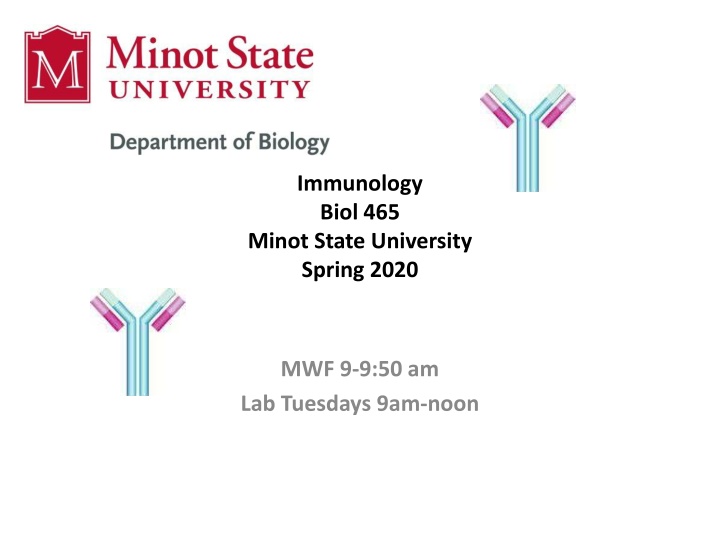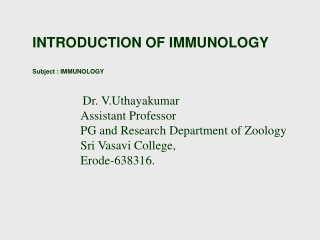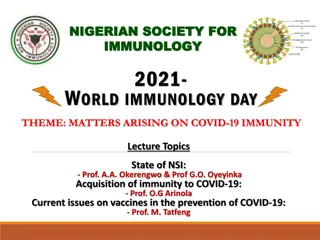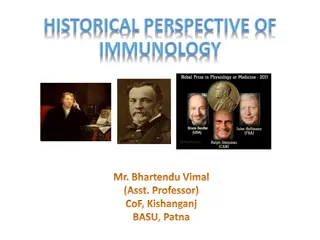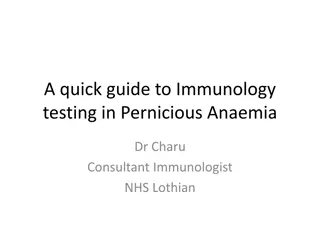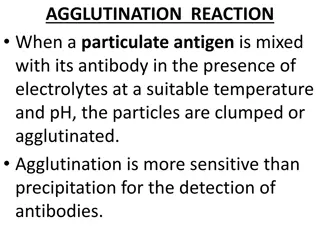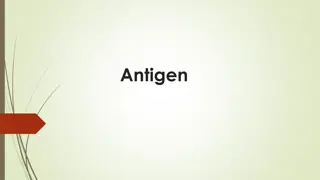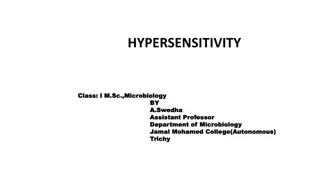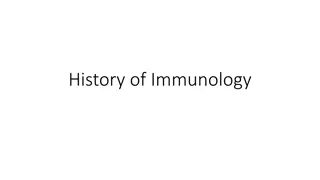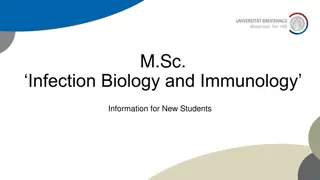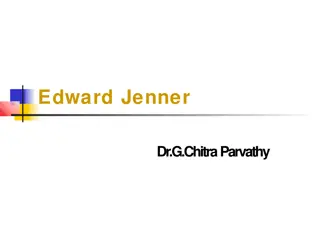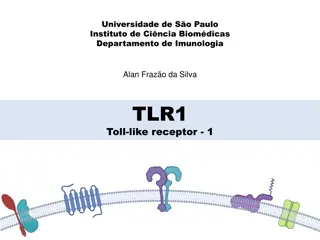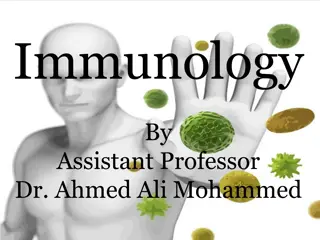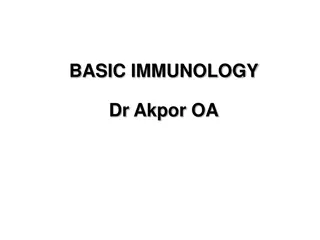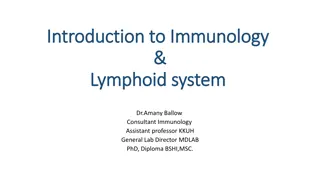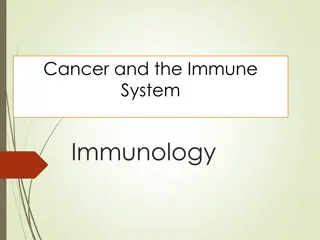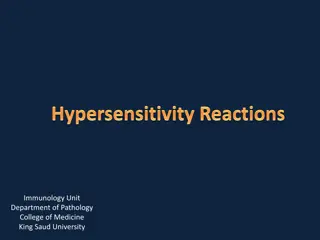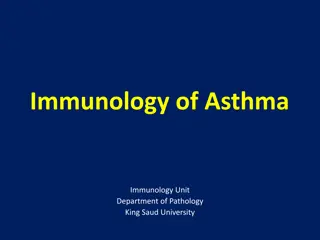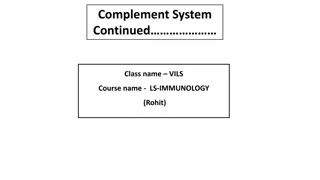Intro to Immunology at Minot State University
This content provides an overview of an immunology course at Minot State University, covering topics such as course organization, immune cells, pathogens, immune responses, and more. It discusses innate and adaptive immune responses, immunological recognition, and examples of immune cells in action.
Download Presentation

Please find below an Image/Link to download the presentation.
The content on the website is provided AS IS for your information and personal use only. It may not be sold, licensed, or shared on other websites without obtaining consent from the author.If you encounter any issues during the download, it is possible that the publisher has removed the file from their server.
You are allowed to download the files provided on this website for personal or commercial use, subject to the condition that they are used lawfully. All files are the property of their respective owners.
The content on the website is provided AS IS for your information and personal use only. It may not be sold, licensed, or shared on other websites without obtaining consent from the author.
E N D
Presentation Transcript
http://t2.gstatic.com/images?q=tbn:ANd9GcQ04uF7Fv53E7ra-DouSIVT60a6sQ7Nr5Uftmk25Pv-rFYVUv8czOB8TNkhttp://t2.gstatic.com/images?q=tbn:ANd9GcQ04uF7Fv53E7ra-DouSIVT60a6sQ7Nr5Uftmk25Pv-rFYVUv8czOB8TNk Immunology Biol 465 Minot State University Spring 2020 http://t2.gstatic.com/images?q=tbn:ANd9GcQ04uF7Fv53E7ra-DouSIVT60a6sQ7Nr5Uftmk25Pv-rFYVUv8czOB8TNk MWF 9-9:50 am Lab Tuesdays 9am-noon
Lecture 2 January 17, 2020 Course organization and information: Website--http://msubiology.info/node/39 Any trouble accessing and using?---Let s explore some resources. Please turn in your assignment?
Where were we? What is immunology? What are some cells mentioned in the first lecture, that have an immune response role? Draw them like your text. What types of pathogens must the immune system deal with? Name a couple, and the diseases caused by them. What are the 2 primary types of immune responses? Which occurs earliest when we take in a pathogen? What do we mean by self and non-self, in immunology?
2 basic types of immune responses 1. Innate immune response Rapid (minutes to hours) *Non-specific but directed against pathogens Requires no previous exposure to pathogen Does not induce immunological memory (the ability the immune system to rapidly engage to kill a pathogen that has infected the host before). Found in some form in nearly all plants and animals.
2. Adaptive immune response Acquired after previous exposure to pathogen Slow(weeks) to develop (at initial exposure) Very specific cells involved recognize a specific pathogen and even a very specific part of the pathogen, which we call an antigen. Responses seen in jawed vertebrates (fairly recently evolved trait)
Innate responses precede adaptive responses Within hours of acquiring a pathogen, specific cells (like macrophages) can see something about the pathogen that distinguishes it from cells of the host (self). This is called immunological recognition. The macrophage cell may do a number of things to start to eliminate the pathogen.
Examples?... 1. Macrophages are phagocytes---can move gobble up some pathogens or components of pathogens. 2. Macrophages can initiate a series of events known as inflammation. Inflammation can contain (wall off) a pathogen and prevent spread of the pathogen.
Cells directly involved in innate immunity Lymphocytes
Adaptive immunity follows innate immunity and involves lymphocytes. Innate responses trigger adaptive responses which may take 2 or more weeks to peak. Example? Macrophages show bits of a pathogen to lymphocytes which respond with YIKES lets get serious about killing this invader
Cells directly involved in adaptive immunity
Eventually activities of lymphocytes rid the body completely of the pathogen. Even better the host is now primed to act quickly and powerfully if the pathogen is encountered again. Even, even better the host s immune system will remember this pathogen for a long time maybe for the life of the host. Immunological memory.
This is the basis of most immunizations! Exposure to an antigen from a pathogen usually rendered harmless, but biologically intact/active. (e.g. a killed virus, or specific viral protein) Initiation of immune response Innate Adaptive Development of immunological memory so that the pathogen will not establish a harmful infection when encountered
Once immunological memory is established, reinfection with the same pathogen induces a rapid, adaptive response (without need for innate immune response). The immune system is said to be primed for recognition of that pathogen.
Figure 1-23 Antibodies are produced by B- lymphocytes
Before we move onlets define just what it is that allows cells of the immune system to recognize someting as not self . Some molecule or structure of the pathogen is physically bound by a receptor on one or more cells of the immune system. The pathogen part is known as the antigen
Adaptive immunity requires that B- and T- lymphocytes have very specialized receptors for recognizing pathogens/antigens. These are called antigen receptors Each antigen receptor can bind to one specific antigen The specific part of the antigen that is bound by the antigen receptor is called the epitope of the antigen.
Different antibodies recognizing 2 epitopes of the same antigen B-cells recognize antigens through antibodies that are anchored in their cell membranes. Later, those same antibodies are released and circulate in the blood.
How B-cells and T-cells see antigens.
One major difference: B-cells (with anchored antibody receptors) can bind to soluble/free, intact antigen. T-cells can bind to a tiny component of a larger antigen AND the antigen must be presented to it by another cell.
Each B- and T- cell has a slightly different antigen receptor that allows it to see a different antigen. (or different epitope of the same antigen) This explains the incredible specificity of the adaptive response.
Since both B and T cells can play a role in the adaptive immune response, we distinguish their unique types of activities. B-cells produce antibodies that circulate in the plasma/liquid part of the blood. Blood was once called humor. B-cells provide humoral immunity
T-cellsact directly or indirectly to kill pathogen-infected host cells. Called cell-mediated immunity
Normal immune responses are a delicate balance of recognizing a pathogen and responding appropriately and at the same time, ignoring tissues, cells, molecules that belong to the host. Called self tolerance
Inappropriate immune responses come in 2 basic forms. 1. Autoimmunity---failure to establish self tolerance. An individual mounts an immune response against body tissue. Lupus Multiple Sclerosis Rheumatoid athritis Graves disease Diabetes
2. Immune failure Immunodeficiency Immunosuppression Normal in babies and elderly Can be caused by the pathogen itself Can be caused by medication Can be inherited genetic defect
Extreme example Severe Combined Immune Deficiency SCID Individual makes no B or T cells. No adaptive immune response at all. Very serious. Bubble Boy disease.
Final thought in our introduction. The study of immunology has allowed development of amazingly specific technologies based on the specificity of antigen and antigen receptors.
Example Antibodies can be used in medical diagnostics, treatment, and monitoring If you purify antibodies that detect a pathogen or molecule of interest say the HIV virus or its proteins, you can use those antibodies to detect HIV in a person s blood. The antibody can be altered in a way to make it visible. (like adding a fluorescent molecule)
Antibodies can even block normal interactions of cell receptors and their ligands (things that bind receptors). Some disease treatments include antibodies to block receptors. Breast cells can be blocked from binding estrogen which can make them divide abnormally---breast cancer. Basis of a drug called Herceptin
Immune checkpoint blockade therapy uses antibodies to block the normal receptors that suppress immune T-cells from killing cancer cells. The block by binding antibodies releases the brakes on the immune system. Anti-PD-1 therapy is treatment with antibodies that bind to PD-1.
